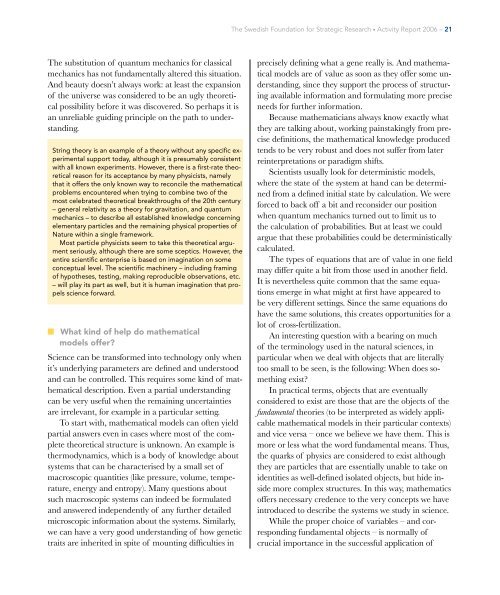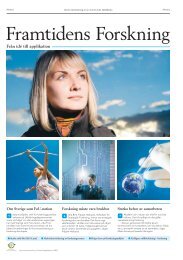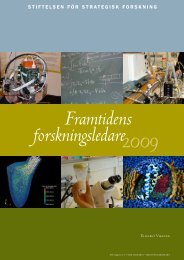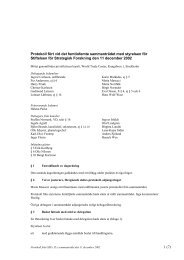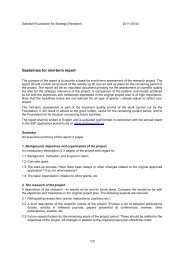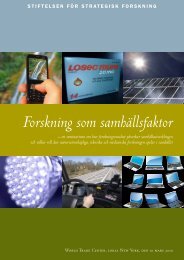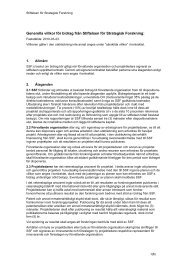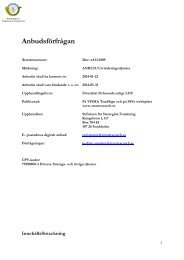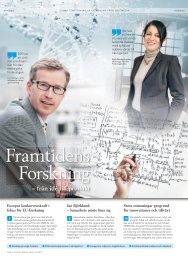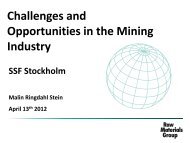Swedish Foundation for Strategic Research Activity Report 2006
Swedish Foundation for Strategic Research Activity Report 2006
Swedish Foundation for Strategic Research Activity Report 2006
You also want an ePaper? Increase the reach of your titles
YUMPU automatically turns print PDFs into web optimized ePapers that Google loves.
The <strong>Swedish</strong> <strong>Foundation</strong> <strong>for</strong> <strong>Strategic</strong> <strong>Research</strong> • <strong>Activity</strong> <strong>Report</strong> <strong>2006</strong> – 21The substitution of quantum mechanics <strong>for</strong> classicalmechanics has not fundamentally altered this situation.And beauty doesn’t always work: at least the expansionof the universe was considered to be an ugly theoreticalpossibility be<strong>for</strong>e it was discovered. So perhaps it isan unreliable guiding principle on the path to understanding.String theory is an example of a theory without any specific experimentalsupport today, although it is presumably consistentwith all known experiments. However, there is a first-rate theoreticalreason <strong>for</strong> its acceptance by many physicists, namelythat it offers the only known way to reconcile the mathematicalproblems encountered when trying to combine two of themost celebrated theoretical breakthroughs of the 20th century– general relativity as a theory <strong>for</strong> gravitation, and quantummechanics – to describe all established knowledge concerningelementary particles and the remaining physical properties ofNature within a single framework.Most particle physicists seem to take this theoretical argumentseriously, although there are some sceptics. However, theentire scientific enterprise is based on imagination on someconceptual level. The scientific machinery – including framingof hypotheses, testing, making reproducible observations, etc.– will play its part as well, but it is human imagination that propelsscience <strong>for</strong>ward.n What kind of help do mathematicalmodels offer?Science can be trans<strong>for</strong>med into technology only whenit’s underlying parameters are defined and understoodand can be controlled. This requires some kind of mathematicaldescription. Even a partial understandingcan be very useful when the remaining uncertaintiesare irrelevant, <strong>for</strong> example in a particular setting.To start with, mathematical models can often yieldpartial answers even in cases where most of the completetheoretical structure is unknown. An example isthermodynamics, which is a body of knowledge aboutsystems that can be characterised by a small set ofmacroscopic quantities (like pressure, volume, temperature,energy and entropy). Many questions aboutsuch macroscopic systems can indeed be <strong>for</strong>mulatedand answered independently of any further detailedmicroscopic in<strong>for</strong>mation about the systems. Similarly,we can have a very good understanding of how genetictraits are inherited in spite of mounting difficulties inprecisely defining what a gene really is. And mathematicalmodels are of value as soon as they offer some understanding,since they support the process of structuringavailable in<strong>for</strong>mation and <strong>for</strong>mulating more preciseneeds <strong>for</strong> further in<strong>for</strong>mation.Because mathematicians always know exactly whatthey are talking about, working painstakingly from precisedefinitions, the mathematical knowledge producedtends to be very robust and does not suffer from laterreinterpretations or paradigm shifts.Scientists usually look <strong>for</strong> deterministic models,where the state of the system at hand can be determinedfrom a defined initial state by calculation. We were<strong>for</strong>ced to back off a bit and reconsider our positionwhen quantum mechanics turned out to limit us tothe calculation of probabilities. But at least we couldargue that these probabilities could be deterministicallycalculated.The types of equations that are of value in one fieldmay differ quite a bit from those used in another field.It is nevertheless quite common that the same equationsemerge in what might at first have appeared tobe very different settings. Since the same equations dohave the same solutions, this creates opportunities <strong>for</strong> alot of cross-fertilization.An interesting question with a bearing on muchof the terminology used in the natural sciences, inparticular when we deal with objects that are literallytoo small to be seen, is the following: When does somethingexist?In practical terms, objects that are eventuallyconsidered to exist are those that are the objects of thefundamental theories (to be interpreted as widely applicablemathematical models in their particular contexts)and vice versa – once we believe we have them. This ismore or less what the word fundamental means. Thus,the quarks of physics are considered to exist althoughthey are particles that are essentially unable to take onidentities as well-defined isolated objects, but hide insidemore complex structures. In this way, mathematicsoffers necessary credence to the very concepts we haveintroduced to describe the systems we study in science.While the proper choice of variables – and correspondingfundamental objects – is normally ofcrucial importance in the successful application of


